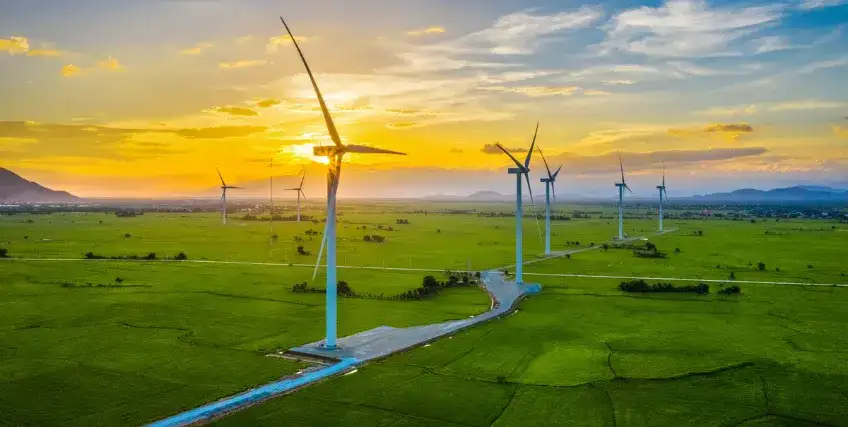Green Energy Funding in Emerging Markets: Opportunities, Risks & Scale-Up Paths
October 24, 2025 | Last Updated on: October 24, 2025

Clean energy has become an increasing priority across the world, and emerging markets are part of the renewable transition. These markets consist of territories like the Sub-Saharan African continent, Southeast Asia, Latin America, and Eastern Europe. Although these regions are seeing increased energy needs, they've been underserved by the broader energy sector.
While clean energy projects and startups have historically been well-received by private investors and government grant programs, the current U.S. political landscape indicates a change in this pattern.
This potentially opens the door for banks and fintechs to play a bigger funding role for SMEs in the clean energy market. It also presents an opportunity to drive sustainability, growth, and ROI for your financial institution.
This article explores the green energy funding landscape in emerging economies and outlines key opportunities, major risks, and strategic pathways for scalability.
Why Emerging Markets Matter in the Green Energy Shift
Developing and emerging economies accounted for more than 80% of global energy demand growth in 2024, according to the International Energy Agency (IEA). The largest share of the growth was due to renewable energy (38%) and natural gas (28%), followed by coal, oil, and nuclear energy.
A cleaner energy future for the planet relies not just on innovation at home, but also on developing countries embracing renewable energy technology. Emerging markets present both opportunities and challenges to the United States from an economic standpoint, especially with divided political interests and priorities.
Recent developments involving actions from the Trump administration have stirred uncertainty about the future of federally funded green project investments.
On October 2, 2025, the Department of Energy (DOE) formally withdrew over 7.5 billion of clean energy awards and tax credits dedicated to grid modernization, energy efficiency, and large-scale renewable energy projects.
There have been numerous developments that change how, when, and where the U.S. engages in global energy development — and how it supports green energy funding across borders.
Opportunities in Green Energy Funding in Emerging Markets
With rapid industrialization and population growth in emerging markets, energy needs are increasing. There's an overwhelming demand for financing renewable energy projects. This presents a scalable opportunity for banks to diversify their loan portfolios and meet long-term sustainability goals.
Some key lending opportunities are:
- Project finance for utility-scale solar, wind, and hydro projects
- SME loans for distributed renewable energy (i.e., mini-grids/solar installers)
- Equipment leasing and vendor finance for the clean tech supply chain
- Working capital loans for energy service companies (ESCOs) in energy efficiency
In emerging markets, community banks and green banks reduce risk through sustainability partnerships and other green energy funding sources. Additionally, there's a growing interest in innovative financial structures that increase green energy funding accessibility for SMEs and rural communities who have traditionally been underserved by mainstream lenders.
The Green Energy Funding Gap
Significant financing gaps exist for SMEs needing funding for green energy projects. Addressing these gaps requires scalable funding opportunities that can adapt to the complexities of the energy sector in emerging economies.
Common Funding Gaps
- Early-stage capital: The majority of start-ups lack access to seed or venture funding to validate and pilot their processes or technologies.
- Project development funding gap: Many costs incurred before construction go unfunded, which frequently results in halting a promising project.
- Local currency lending: The mismatch of investment being in foreign currency and revenue in local currency increases the risk of non-repayment.
Key Challenges for Lenders
- Perceived risks: Political instability, regulatory unpredictability, and weak contract enforcement deter long-term lending.
- Limited technical capacity: Banks in emerging markets may not have the technical capabilities to underwrite renewable energy loans.
- Lack of data: Incomplete market and performance data create challenges for due diligence, process, and cost.
- High transaction costs: Small projects often involve disproportionately high legal and administrative costs.
Risk Landscape in Emerging Markets
Emerging markets are easily impacted by fluctuating energy policies, funding eligibility criteria, bureaucratic hurdles, and regulatory barriers. Political changes, like the flip-flopping seen between the President Trump and Biden eras, can deter long-term investors in green energy funding initiatives.
Underdeveloped Supply Chains
The inability to source materials domestically for manufacturing solar panels, batteries, or turbines results in a reliance on foreign markets. This often increases the overall project. Building local supply chains supported by green energy funding can reduce project costs.
Lack of Technical Expertise and Workforce
Education and workforce development are essential. Targeted green energy funding can support training programs to create a pipeline of skilled professionals in the installation, maintenance, and management of clean energy systems.
Access to financing
Many banks are reluctant to finance energy projects that are higher risk. Alternative funding approaches, such as grant programs, blended sources of financing, and low-interest loans, can close the green energy funding gap and decrease the risk.
Scalable Models for Green Energy Financing
Scaling green energy funding in emerging markets requires moving beyond traditional finance through innovation, risk sharing, and public-private collaboration. This can unlock scalable, lower-risk opportunities for banks and fintechs.
1. Blended Finance
Blended finance combines public money with private investments to make projects less risky. It's a helpful way to raise more capital for renewable energy projects.
- Capital from development banks or other agencies assumes the first-loss position.
- Commercial investors benefit from improved risk-return profiles.
- Technical assistance is often combined to build local capacity and project bankability.
Blended finance has been successfully implemented by the Shell and Rockefeller Foundations, Green Climate Fund, the World Bank, and the U.S. International Development Finance Corporation (DFC), among others.
2. Green Bonds
Green bonds offer long-term, fixed-income investment opportunities that support environmentally friendly projects. These instruments act as vehicles that can provide international funding for domestic energy systems in emerging markets.
Key features:
- Transparent use-of-proceeds requirements
- Certification aligned with global standards
- Strong appeal to ESG-focused investors
Local governments and utilities in countries like Brazil, India, and South Africa have issued green bonds for grid upgrades and clean energy projects. Banks can underwrite, invest in, or structure these instruments to increase liquidity and visibility in sustainable finance markets.
3. Fintech-Led and Microfinance Models
Fintechs are driving clean energy adoption in off-grid and peri-urban areas through Pay-As-You-Go (PAYG) systems. These models offer small-scale, recurring payments for home solar systems, allowing users to pay for energy as they consume it.
How it works:
- Payments are made through mobile money platforms.
- Customers build credit history.
- Financiers can switch the system off in the event of non-payment.
Banks and Fintechs can co-lend, securitize PAYG receivables, or offer digital wallets tied to clean energy purchases. This lowers the barrier to entry for low-income households while building a new class of bankable customers.
4. Public-Private Risk Sharing
Multilateral institutions like the International Finance Corporation (IFC), African Development Bank, and the U.S. Department of Energy sometimes provide partial credit guarantees or liquidity support. These are critical in emerging markets where long-term credit risk remains high.
Benefits for banks and Fintechs:
- Greater confidence in lending to first-time borrowers
- Improved project bankability
- Lower capital provisioning requirements
Political risk insurance, currency risk hedges, or partial risk guarantees are essential tools for creating financing deals that are more attractive and scalable.
5. Aggregated Financing Platforms
For smaller renewable energy projects, like mini-grids, rooftop solar, or energy efficiency retrofits, banks and Fintechs can bundle similar projects into a larger portfolio, reducing per-project transaction costs and improving investment metrics.
Platform benefits:
- Easier due diligence and risk assessment
- More efficient capital deployment
- Potential to securitize or sell project portfolios
These platforms may be managed by regional development banks, often with low-interest funding to attract private investors.
6. Digital Credit & Embedded Financing
Using transaction data, mobile usage, or remote monitoring, Fintechs can underwrite clean energy loans at a low cost. These embedded finance models work especially well in PAYG renewable energy systems or small-scale energy-efficient appliances.
Opportunities include:
- Quick credit decisioning
- Dynamic repayment terms tied to energy use
- Integration with mobile energy apps and wallets
Traditional banks partnering with digital lenders can provide an entry point into rural or unbanked markets while building a future pipeline of customers and data.
Conclusion
As the global energy ecosystem changes, emerging markets will be at the cusp of the clean energy transition, presenting substantial opportunities and risks for investors, banks, and fintechs.
These fresh opportunities come as the U.S. has changed its policies and reduced public funding. For the green energy momentum to continue, the private sector, banks, and fintechs will need to be active participants in bridging green energy funding gaps and scaling up viable renewable energy strategies.
Launching a green lending division or green bank that focuses on high-growth SME sectors, such as solar and other renewable energy projects, is a worthwhile consideration.
Innovative models — including blended finance, green bonds, PAYG, and digital credit — are crucial for achieving inclusive energy access across emerging markets. Coordinated green energy funding across borders is essential.
FAQs About Green Energy Funding
1. What is green energy funding?
Green energy funding is a way of generating capital to support the development of clean energy technologies such as solar, wind, and hydroelectric power plants.
2. Why is green energy funding important for emerging markets?
Emerging markets contend with increasing energy demand, urbanization, and unreliable infrastructure. Green energy funding can generate capital for energy projects that lead to clean energy, job creation, economic development, and resilience to climate change.
3. What are some renewable energy funding sources?
Renewable energy grants from government, private sector investors, and philanthropic organizations are a good place to start. Grant funds are then often used in combination with loans from banks and other financial institutions.
4. Are there government programs that provide green energy grants?
The U.S. still offers grants for green energy through agencies like the U.S. Department of Energy (DOE), Environmental Protection Agency (EPA) and United States Department of Agriculture (USDA). These programs continue to publish funding opportunity announcements and competitive grant calls. However, several initiatives announced under earlier administrations have undergone changes in 2025, so applicants are advised to stay updated on program status and funding availability.
5. How can fintechs and banks contribute to green energy funding?
Banks and fintechs are filling the funding gap left by reduced government funding. They're offering project finance, equipment leasing, working capital loans, and digital loans for clean energy businesses.
Frequent searches leading to this page
Related Articles
Department of Energy (DOE) Loan Programs Office (LPO): The Complete Guide to Clean Energy Funding
December 5, 2025
Green Energy Funding in Emerging Markets: Opportunities, Risks & Scale-Up Paths
October 24, 2025
Challenges in Green Funds Loans Implementation: Barriers and Solutions
October 14, 2025
Term Loans are made by Itria Ventures LLC or Cross River Bank, Member FDIC. This is not a deposit product. California residents: Itria Ventures LLC is licensed by the Department of Financial Protection and Innovation. Loans are made or arranged pursuant to California Financing Law License # 60DBO-35839




